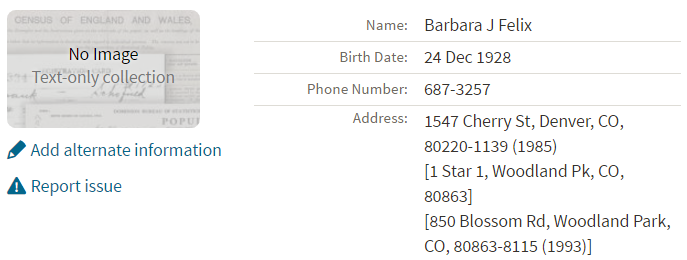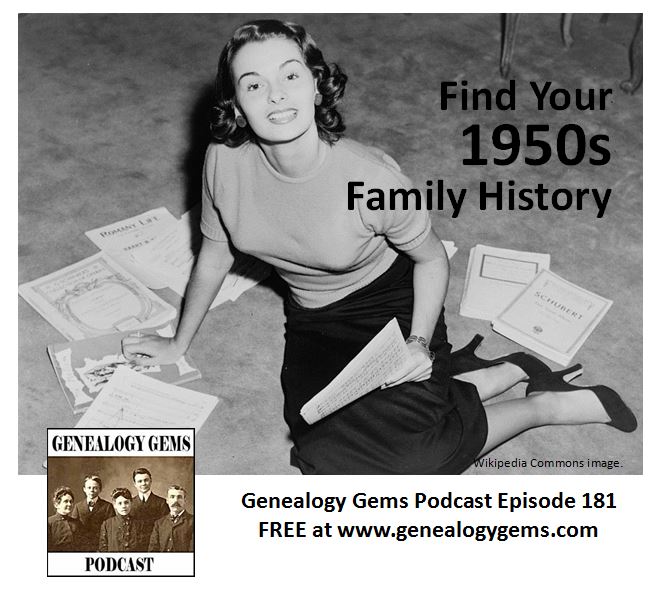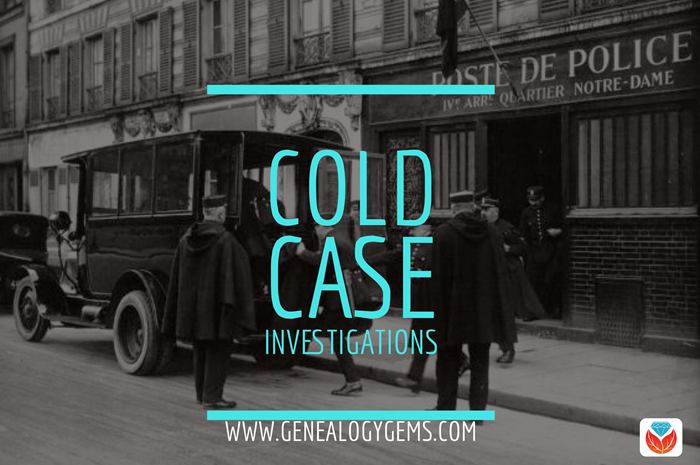by Lisa Cooke | Jun 15, 2016 | 01 What's New, Records & databases, Research Skills |
The US Public Records Index can be useful for genealogy–if you understand what it is and how to use it properly. Here’s an example and some tips.
Not long Russ sent in this tip recommending the US Public Records Index for genealogy:
“I was listening to Genealogy Gems Podcast 181 [in which] you were talking about where do we search while we are waiting for the 1950 Census….I recently discovered a wonderful resource, on Ancestry.com, that I have used along with city directories. The name of the record group doesn’t sound interesting but it can be a Gem for you: the US Public Record Index, 1950-1993, Volume 1 and 2. Volume 1 is far more interesting with more data. A search will return a name AND birth date, along with more than one address, zip code and sometimes phone numbers.”
Here’s a sample search result:

Russ kindly sent me Ancestry’s description of its online database for Volume 1, which says that original data comes from public records spanning all 50 states, such as voter registration lists, public record filings, historical residential records and other household database listings.
Collection Profile
What: U.S. Public Records Index
Where: Ancestry, FamilySearch, MyHeritage
Years Spanned: 1950-2009
Source Type: Lacking original source citations. “Hints to go on and follow up with further research into verifiable sources.”
Then he shared the following example of using the US Public Records Index to find recent relatives that he can’t look up yet in the 1950 census:
“I had a hint for a cousin in a yearbook. I know that she recently lived in Philadelphia, Pennsylvania. I didn’t know where she went to college and I know her birthday. The name is not unique, not also not common. At the same time, I had the hint for the Public Record Index. You know those things we can’t use in a proof argument, but there [she] was in Philadelphia. The yearbook had her picture and only her name, not spelled the way I know it, but the Public Record Index puts her in Philadelphia at the right time and place.
I have seen 2 or 3 addresses for folks in the 1980s and 1990s in these indexes. Not all addresses have dates, but some do. I have one cousin with 5 addresses since 1983 and he won’t be in a census until the 1960 Census Records are released.”
Russ blogs about his family history at worthy2be.wordpress.com/. Thanks for the tip!
The U.S. Public Records Index pops up in my search results sometimes, too. Both volume 1 and volume 2 are searchable on Ancestry.com, as Russ says, in separate databases. Each has over 400,000 records in it. There’s also a free partial version of this database for 1970-2009 at FamilySearch.org and yet a third version at MyHeritage, with 816 million records, with nearly the same time frame. The FamilySearch database says its data comes from “telephone directories, property tax assessments, credit applications, and other records available to the public.”
More on the US Public Records Index
Here are a few tips worth mentioning about the US Public Records Index. Some of these points come from the FamilySearch wiki:
- Not everyone who lived in the U.S. appears in the index, and you’re more likely to find birth information for those born between 1900 and 1990. What you’ll find is primarily where someone lived, and often when they lived there.
- It’s rarely possible to positively identify a relative in this index since there’s limited information and it spans the entire country for up to a half-century, and you can’t follow up on the record it comes from because the index doesn’t say where individual records come from. So as Russ says, this is a great resource to use in combination with other records. It’s a similar concept to the way you might consult family trees that lack sources: hints to go on and follow up with further research into verifiable sources.
- When you find more recent listings, you can sometimes find telephone numbers for living distant relatives. If the thought of cold-calling distant relatives seems a little intimidating, listen to my Family History: Genealogy Made Easy podcast, episodes 14-15, for tips–and to get your courage up!
 More Gems on Researching Recent Relatives
More Gems on Researching Recent Relatives
by Lisa Cooke | Apr 30, 2014 | 01 What's New, Family Tree Magazine, Research Skills, Technology

We’ve all got genealogy brick walls in our research: family mysteries we have so far found unsolvable. In the new issue of Family Tree Magazine (May/June 2014), Lisa’s got a great article packed with 14 strategies for SOLVING those perplexing questions.
The article is “Warming Up a Cold Case,” and it’s got a fun criminal investigator theme. I won’t give all 14 of her tips away, but some of my favorites include re-examining old evidence, finding new witnesses and going on a genealogical stakeout. And one that made me laugh out loud: “Post wanted posters.” And then I just had to put my ancestor’s face on a wanted poster (right).
How do you really create a wanted poster for your ancestor? Lisa shares these ideas in the article:
1. Post their names on genealogy online message boards (like at Ancestry.com). But fill in those “wanted” details. Instead of height, weight and hair color, add what you know about their births, marriages, deaths, family relationships and residences.
2. Post your family tree online at any number of sites for free. Sites organize their trees in one of two ways. Ancestry.com, MyHeritage.com and others can i buy medication without insurance offer the individual tree model. You upload (or build on the site) and maintain your own tree. FamilySearch.org, WikiTree, Geni.com and WeRelate.org are community tree sites. You may work from a view of your own tree, but the site is merging your tree with others behind the scenes to create a single world family tree (each does this a slightly different way).
3. Start your own family history blog. Write keyword-rich blog posts that make it easy for Google searchers to find your ancestors there. Check out Lisa’s free four-part series on how to create a genealogy blog at the Genealogy Gems YouTube Channel. This link will take you to the 4 part video playlist.

Find the entire article in the May/June issue Family Tree Magazine. Even better: Genealogy Gems Premium Members can also watch Lisa’s one hour video class Brick Walls: Cold Case Investigative Techniques. Not a Premium Member yet? You’re missing out on 24/7 access for a year to some of her most popular classes on Google, Google Earth, organization, Evernote, newspaper research and more. Learn more about Genealogy Gems Premium Membership here.
by Lisa Cooke | May 6, 2015 | 01 What's New, images, Maps, Premium Video, Research Skills, YouTube
 Looking for a pre-1700 map of the Americas as the Europeans found it? Yearning to survey the plot of land your ancestors tilled in Cobb County, Georgia? Historic maps can point you in the direction of your ancestors. But navigating your way to an original map can be a costly and time-consuming trek. Before you venture down that road, navigate your way to the treasury of digitized maps available online!
Looking for a pre-1700 map of the Americas as the Europeans found it? Yearning to survey the plot of land your ancestors tilled in Cobb County, Georgia? Historic maps can point you in the direction of your ancestors. But navigating your way to an original map can be a costly and time-consuming trek. Before you venture down that road, navigate your way to the treasury of digitized maps available online!
A new video class can help Genealogy Gems Premium members do just that: Best Websites for Finding Historical Maps. Literally hundreds of thousands of historical maps are available for free online in high-resolution digital format that you can download right to your computer without ever leaving home. The websites I show you offer some of the largest map collections available on the Internet today. I demonstrate strategies for searching the best websites for historical maps that will help YOUR research. You’ll see what’s out there, how to find the right maps and how to download and use them.
 Genealogy Gems Premium members also have access to my popular online video class, 5 Ways to Enhance Your Genealogy Research with Old Maps. Not a Premium member? Get a taste of these classes for free on the Genealogy Gems YouTube channel! Check out this free excerpt: “Using Sanborn Fire Maps for Family History and Genealogy.”
Genealogy Gems Premium members also have access to my popular online video class, 5 Ways to Enhance Your Genealogy Research with Old Maps. Not a Premium member? Get a taste of these classes for free on the Genealogy Gems YouTube channel! Check out this free excerpt: “Using Sanborn Fire Maps for Family History and Genealogy.”
by Lisa Cooke | Apr 30, 2016 | 01 What's New, Records & databases
 How great to see these new genealogy records online! Those with German roots will especially want to check out new resources on Ancestry.com.
How great to see these new genealogy records online! Those with German roots will especially want to check out new resources on Ancestry.com.
ENGLAND CHURCH. Findmypast.com has updated its collections of church baptismal and marriage records for Dorset, England. Those collections now together number about a million records.
GERMANY – MILITARY. Over 400,000 records are part of a new Ancestry.com collection of Bremen military lists (1712-1914). According to the collection description, “The core of the collection are the muster rolls created by recruiting commmissions including actual musters from 1894-1917 for men born between 1874 and 1899. These records are arranged in chronological-alphabetical order and contain detailed information about male military personnel in the city.”
GERMANY – CHURCH. An enormous collection of Lutheran baptisms, marriages and burials is now searchable on Ancestry.com. You’ll find over 24 million records from “parish registers from numerous Protestant communities in Baden, today part of the German state of Baden-Württemberg…[and]some communities to the north, such as Wiesbaden in adjacent Hessen.” Another new Ancestry.com collection contains over a million birth, marriage and death records taken from weekly church reports in Dresden, Germany for 1685-1879.
GERMANY – IMMIGRATION TO U.S. A new database on Ancestry.com catalogs German immigrants to the U.S., 1712-1933.
IRELAND NEWSPAPERS. Over half a million new Irish newspaper articles have been added at Findmypast.com. According to a company press release, “Significant updates have also been made to seven existing titles” and a new title from Northern Ireland for 1891-1896 is a “must-read for anyone with ancestors from that part of the country.”
U.S. – NEVADA DEATHS. Just over a quarter million records are part of a new Ancestry.com collection of Nevada death records for 1911-1965. The indexed images are state death certificates.
 Got German roots? Click here to read an article on German newspapers in the U.S.
Got German roots? Click here to read an article on German newspapers in the U.S.
by Sunny | Apr 5, 2018 | 01 What's New |
Genealogy Gems Premium Podcast Episode 157 is ready for you! This episode features a variety of must-have tips for the family historian: courthouse research strategies, identifying old family memorabilia, and using YDNA to learn more about your paternal line....

 More Gems on Researching Recent Relatives
More Gems on Researching Recent Relatives




 How great to see these new genealogy records online! Those with German roots will especially want to check out new resources on Ancestry.com.
How great to see these new genealogy records online! Those with German roots will especially want to check out new resources on Ancestry.com.